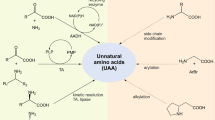Abstract
The hydrolytic specificity of the recombinant 20S proteasome from the deep-sea thermophile Methanococcus jannaschii was evaluated toward oxidized insulin B-chain across a range of temperatures (35°, 55°, 75°, and 90°C) and hydrostatic pressures (1, 250, 500, and 1,000 atm). Of the four temperatures considered, the same maximum overall hydrolysis rate was observed at both 55° and 75°C, which are much lower than the T opt of 116°C previously observed for a small amide substrate (Michels and Clark 1997). At 35°C the rates of cleavage were highest at the carboxyl side of glutamine and leucine, whereas at the three higher temperatures, the most rapid cleavages occurred after leucine and glutamic acid residues. The distribution of proteolytic fragments and the cleavage sequence also varied between the lowest and higher temperatures. Application of hydrostatic pressure did not increase proteasome activity, as observed previously for the amide substrate (Michels and Clark 1997), but instead significantly reduced the overall conversion of the polypeptide substrate. Overall cleavage patterns observed for the recombinant M. jannaschii proteasome were similar to those reported previously for Thermoplasma acidophilum (Akopian et al. 1997) and human proteasomes (Dick et al. 1991), indicating that proteasome specificity has been conserved despite significant environmental diversity.






Similar content being viewed by others
References
Akopian TN, Kisselev AF, Goldberg AL (1997) Processive degradation of proteins and other catalytic properties of the proteasome from Thermoplasma acidophilum. J Biol Chem 272:1791–1798
Boonyaratanakornkit BB, Park CB, Clark DS (2002) Pressure effects on intra- and intermolecular interactions within proteins. Biochim Biophys Acta 1595:235–249
Chen P, Hochstrasser M (1995) Biogenesis, structure and function of the yeast 20S proteasome. EMBO J 14:2620–2630
Dick LR, Moomaw CR, DeMartino GN, Slaughter CA (1991) Degradation of oxidized insulin B-chain by the multiproteinase complex macropain (proteasome). Biochemistry 30:2725–2734
Djaballah H, Rowe AJ, Harding SE, Rivett AJ (1993) The multicatalytic proteinase complex (proteasome): structure and conformational changes associated with changes in proteolytic activity. Biochem J 292:857–862
Frankenberg RJ, Hsu TS, Yakota, H, Kim R, Clark DS (2001) Chemical denaturation and elevated folding temperatures are required for wild-type activity and stability of recombinant Methanococcus jannaschii 20S proteasome. Protein Sci 10:1887–1896
Fukuda M, Kunugi S (1984) Pressure dependence of thermolysin catalysis. Eur J Biochem 142:565–70
Hei DJ, Clark DS (1994) Pressure stabilization of proteins from extreme thermophiles. Appl Environ Microbiol 60:932–939
Heremans K (1982) High pressure effects on proteins and other biomolecules. Annu Rev Biophys Bioeng 11:1–21
Kisselev AF, Akopian TN, Castillo V, Goldberg AL (1999) Proteasome active sites allosterically regulate each other, suggesting a cyclical bite-chew mechanism for protein breakdown. Mol Cell 4:395-402
Lowe J, Stock D, Jap B, Zwickl P, Baumeister W, Huber R (1995) Crystal structure of the 20S proteasome from the archaeon T. acidophilum at 3.4A resolution. Science 268:533–539
Maupin-Furlow JA, Aldrich HC, Ferry JG (1998) Biochemical characterization of the 20S proteasome from the methanoarchaeon Methanosarcina thermophila. J Bact 180:1480–1487
McGuire MJ, DeMartino GN (1989) The latent form of macropain (high molecular-weight multicatalytic protease restores ATP dependent proteolysis to soluble extracts of BHK fibroblasts pre treated with anti-macropain antibodies. Biochem Biophys Res Comm 160:911–916
Michels PC, Clark DS (1997) Pressure enhanced activity and stability of a hyperthermophilic protease from a deep sea methanogen. Appl Environ Microbiol 63:3985–3991
Miller JF, Nelson CM, Ludlow JM, Shah NN, Clark DS (1988) Pressure and temperature effects on growth and methane production of the extreme thermophile Methanococcus jannaschii. Appl Environ Microbiol 54:3039–3042
Miller JF, Shah NN, Nelson CM, Ludlow JM, Clark DS (1989) High pressure-temperature bioreactor: assays of thermostable hydrogenase with fiber optics. Biotechnol Bioeng 34:1015–1021
Murakami Y, Matsufuji S, Kamenji T, Hayashi S, Igarashi K, Tamura T, Tanaka K, Ichihara A (1992) Ornithine decarboxylase is degraded by the 26S-proteasome without ubiquitination. Nature 360:597–599
Rubin DM, Finley D (1995) The proteasome: a protein-degrading organelle? Curr Biol 5:854–858
Seufert W, Jentsch S (1992) In vivo function of the proteasome in the ubiquiting pathway. EMBO J 11:3077–3080
Wilson HL, Ou MS, Aldrich HC, Maupin-Furlow JA (2000) Biochemical and physical properties of the Methanococcus jannaschii 20S proteasome and PAN, a homolog of the ATPase (Rpt) subunits of the eucaryal 26S proteasome. J Bacteriol 182:1680–1692
Wenzel T, Eckerskorn C, Lottspeich F, Baumeister W (1994) Existence of a molecular ruler in proteasomes suggested by the analysis of degradation products. FEBS Lett 349:205–209
Yamada S, Hojo K, Yoshimura H, Ishikawa K (1995) Reaction of 20S proteasome: shift of SDS-dependent activation by divalent cations. J Biochem 117:1162–1169
Yamada S, Sato K, Yamada J, Yasutomi M, Tokumoto T, Ishikawa K (1998) Activation of the 20S proteasome of Xenopus oocytes by SDS: evidence for the substrate-induced conformational change characteristic of trypsin-like peptidase. Zool Sci 115:353–357
Zwickl P, Grziwa A, Puhler G, Dahlmann B, Lottspeich F, Baumeister W (1992) Structure of the Thermoplasma proteasome and its implications for the function and evolution of the multicatalytic proteinase. Biochemistry 31:964–972
Acknowledgments
This research was supported by the Bayer Corparation, UCSF/NIGMS (R25GM6847-02), NSF (BES-0224733), the Schlumberger Fellowship of DSC, and the Kyowa Hakko Kogyo Co. The authors would like to thank Michael Ru for his assistance in preparing the manuscript, and the following for their helpful contributions: David Altreuter, Tina Hsu, Richard Carrillo, and Peter Zwickl.
Author information
Authors and Affiliations
Corresponding author
Additional information
Communicated by G. Antranikian
Rights and permissions
About this article
Cite this article
Frankenberg, R.J., Andersson, M. & Clark, D.S. Effect of temperature and pressure on the proteolytic specificity of the recombinant 20S proteasome from Methanococcus jannaschii . Extremophiles 7, 353–360 (2003). https://doi.org/10.1007/s00792-003-0330-y
Received:
Accepted:
Published:
Issue Date:
DOI: https://doi.org/10.1007/s00792-003-0330-y




